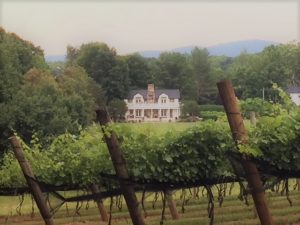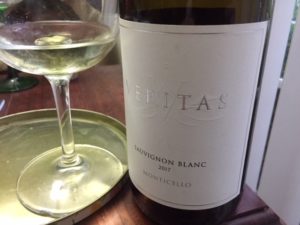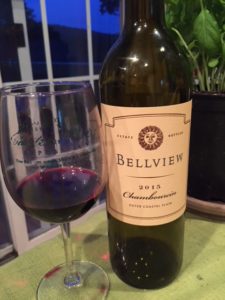A recent visit to Fox Meadow Vineyards at the western edge of Fauquier County reminded me what a stunning view they have from their elevation of some 1,800 feet–and how that elevation is shown in their wines by way of bright natural acidity. Tasting highlights:
- Le Reynard Gris 2016: A proprietary blend of chardonnay, pinot gris and vidal, the wine resembles a sauvignon blanc. Nose: Loire Valley-like fruit and minerality. Palate: round, full, juicy, but finishing with firm acidity. Only 2/10 of 1% residual sugar. Clean finish, good length. A stylish and versatile blend, best from spring through fall. $24.00.
- Chardonnay 2016 (barrel fermented). This elegant example of an oaked chardonnay that could represent Virginia well anywhere was aged in a third new, a third one-year old and a third two-year old oak. Nose: very Meursault-like; some new French oak hints. The lees were stirred every 3-4 weeks and spent 10 months in the oak. Elegant Meursault-style nose of mineral, apple, French oak and lees. On the palate, these elements come together in a complex, elegant way but well-balanced, the richness of the palate balanced by fresh acidity and oak well-integrated with fruit. $28.00
- Freezland White 2016: same grape blend as the Reynard Gris, but with higher residual sugar. Nose: clean and fruity. Palate: wonderfully balanced. Sugar is a bit high (for me) but it works very well for a sweet blend that is also versatile with picnic/grilling food. $22.00.
- Chambourcin 2016: (10% cabernet franc). Bright ruby color. Nose: complex! Great cherry, oak, and spice notes. Palate: complexity of fruit, oak and spice in balance; impressive package for this versatile hybrid grape. (full disclosure: this winery is a client of the author’s.)
Septenary is a new winery on the Monticello Trail west of Charlottesville on Rt. 250 close to Mirador that opened last winter. Their vineyard is mature, and they also buy fruit from a vineyard in Essex Co. at the mouth of the Rappahannock River (one of the oldest in the state). Their name comes from settling for a substitute for Seven Oaks Farm, the historic name of the estate; it turns out that J. Lohr Vineyards in the Central Coast of Callifornia has a line of wines and owns that brand, so they went with a very classy plan B, which includes the Roman numeral VII rendered in U.VA-reminiscent Greek Revival columns. The winemaker is…again…Sebastien Marquet, who has proved himself more than capable with dealing with wine styles in Virginia from sparkling blanc de blancs to Rhone and Italian white wines, to classic red Bordeaux blends.
Septenary Vineyards, Greenwood, Monticello AVA
This winery is not pet or child-friendly, but young and childless or middle-aged wine afficianados need a refuge too, and this winery fits the bill. One enters the current tasting room past the vineyard and through an outdoor lounge area and patio (I’m told ground will be broken for a new tasting room and winery expansion this summer). The tasting room is of elegant decor, and matches the elegant wines nicely. Currently there are three whites; a California vermentino 2016, California viognier 2016 and Virginia viognier 2017, an estate syrah rose, and four red Bordeaux blends from 2014 and 2015. Tasting Highlights:
I was both surprised and impressed by the Septenary California Vermentino 2016 (sourced from Santa Ynez). Aroma and flavor descriptors written on the tasting sheet were very accurate: caramel, almond, honey and citrus. If you’ve had the Barboursville vermentino, this has the same zesty lemon citrus and more palate weight than a pinot grigio, but depth and breadth from its California origins, deftly integrating fruit with oak and adding complexity without subtracting freshness or varietal character.
I’m happy to report that the Viognier, VA 2017* was much like the current model of Virginia viognier, such as you’d see with Barboursville Vineyards. Stainless fermented, the nose is fresh and bright but with subtle lemon/citrus notes. Palate: young, evolving with ripe peach on the mid-palate, rich, luscious and plump but still has fresh lemon acidity on the finish.
Carriage House 2015 is more elegant and easily drinkable than most 2015 reds from the Hurricane Joachin vintage, and is a “Right Bank” (Bordeaux) style blend of merlot and cabernet franc. Nose: leafy/herbal, “Right Bank” typical. On the palate, clean and fresh; broad, spicy ripe black fruits, crunch ripe tannins, clean finish, elegant but quaffable. A fine Virginia red for a summer into fall dinner.
Deacon 2014* (68% cabernet sauvignon, 18% merlot, 14% cabernet franc). The cabernet in this wine came from Septenary’s Essex Co. vineyard, where the longer growing season and (non-clay) well-drained sandy loam soils make better cabernet sauvignon than here in the Monticello heavy clay soils. Color: dark. Nose: closed, tight black fruits. Palate: fruit still mostly closed, but a brilliant texture; crunchy tannins and these tight, well-knit black fruits could go up against cabernet-based blends from the Medoc (Bordeaux) or most comparable California blends; I love the bitter chocolate finish.
Coleman 2014** Another fine Bordeaux-style blend from the great 2014 vintage and also from the Essex County vineyard, this is 40% cabernet sauvignon, and a 3-way split of 20% each from cabernet franc, merlot and petit verdot. Nose: classic fresh cassis-dominated red and black fruit notes, reminiscent of the Left Bank (Bordeaux). On the palate–wow! smoky and spicy with a hint of cigar box, tight, well-knit black fruits. Still evolving, finishes with crunchy ripe tannins and pleasing, bitter chocolate on the finish. This is one to lay down and plan to make an occasion of.
Wine of the Week (White): Veritas Sauvignon Blanc Monticello, 2017**
Vertias winemaker Emily Pelton spoke at the Eastern Winery Exposition in March on sauvignon blanc. She and her family (her parents and the winery founders, Andrew and Patricia Hodson, are British) are such sauvignon blanc partisans, that they often make two different styles in one vintage; a Marlborough, NZ style (in-your-face passion fruit) and an elegant Loire Valley style.
This 2017 is a more elegant Loire style, with gooseberry and gentle white grapefruit on the nose. Palate: you’d think this wine was made from pure white grapefruit, with a hint of passion fruit on the finish. Breath-takingly pure and fresh, fruit-forward, but with enough acidity for balance. Acid is not as high as with the ’16 vintage, but this has remarkable, pure varietal character but is also easy to drink (maybe even quaff) young. Like Ms. Pelton, the wine is both pretty and poised. Enjoy over the summer through next spring.
Wine of the Week (Red): Bellview estate Chambourcin 2015, Outer Coastal Plain, NJ.*
This is a finely balanced, mature example of how varietal chambourcin should be as respected as any other red varietal planted on the East Coast. Color: vibrant violet color, even in maturity. Nose: ripe black cherry, sage, a hint of earth and leather. Palate: very good integration of fruit, acid and oak (in the background), ripe black cherry flavors balanced with smooth tannins and acid, with savory sage notes in the background. Stylistically, much like a Piedmontese dolcetto, great for matching with food from June through September. Mature and drinking well now.
Country Vintner Features a Virginia and New York Varietal Taste-Off
Country Vintner, a Mid-Atlantic distributor geared towards licencees featuring niche and/or high-end quality (not necessarily priced) wines, put on a very original and fun comparative tasting last week at BeerRun, the Charlottesville version of “Cheers” only slightly younger and with take-out as well as on-premise wine and beer sales.
Kyle Boatright of Country Vintner offered a pair of the same varietals from both states to taste and compare. First, there were two rieslings, the Scale House Riesling 2016 from Ox Eye Vineyards, Shenandoah Valley, VA and Forge Cellars’ Riesling 2016, Finger Lakes, NY.
The Ox Eye Scale House Riesling 2016 had an almost watery pale color, with a nose that reminded me right away of Alsatian rieslings, that often have a whiff of Muenster cheese and pear. On the palate, this wine is racy and linear, with lime and green apple flavors, knit with lively acidity. Like good Alsatian rieslings, this needs another 2+ years of age, but continues to evolve. If you buy it, be sure to decant it before drinking and don’t over-chill; will be great with shellfish or raclette. $20.99
Forge Cellars’ Riesling 2016, Finger Lakes, NY: These are both East Coast dry rieslings but a great stylistic contrast. The color on this wine is light gold, implying either some oxidation or skin contact, or both. They describe this wine as having the character of “baked apples, bosc pear, quince paste, ginger and brioche”, all of which hint at an Old World processing that allows some minor oxidation and skin contact with extraction of phenols (flavor and color compounds). The palate is spicy and vibrant with bruised apple flavors, but the finish is clean. This is an unusual style for Finger Lakes riesling but a fine contrast to the first wine, and would make an excellent food wine, especially with Alsatian-style food (lots of pork and potatoes).
Next was a contrast with Virginia and New York lemberger a k a blaufrankisch, a fruity, non-tannic Austrian red grape. Ox Eye Vineyards in the Shenandoah Valley put forward their lemberger 2014, while Red Tail Ridge Vineyards (west Seneca Lake, NY) featured their blaufrankisch non-vintage blend.
Ox Eye Vineyards, Shenandoah Valley, VA Lemberger 2014*: Nose of spicy berry and cherry. Palate: ripe but smooth tannins, lively fresh acidity, fresh berry flavors. Delightfully fresh and vibrant but enough tannins to be given respect. An original, fine varietal expression in a great vintage for Virginia reds.
Red Tail Ridge Vineyards Blaufrankisch NV Finger Lakes, NY: Nose: fresh boysenberry and rose petal. Inviting. On the palate, very high acid! Violets, red berry and cherry fruit flavors, no obvious oak but needs another year to tone down the tart acidity.
Rating key: * = very good, ** = exceptional



